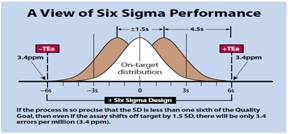Six Sigma Metrics and Quality Control in Clinical Laboratory
Abstract
Quality control in healthcare system is still less understood because of the relative complexity in choosing an appropriate Westgard rule .Six Sigma methodology is a manufacturing strategy first pioneered by Motorola Company in 1980s, with the goal of decreasing the defect rates in production. It has improved the production efficiency of different industries. To achieve the similar high quality and near zero defect rates in healthcare system, six sigma metrics is being used in many clinical laboratories and diagnostic industry. Six sigma metrics is used in combination with total allowable error (CLIA ’88 proficiency testing criteria), method imprecision and bias. The goal is to attain the highest possible sigma scale within the acceptable limits of total allowable error. This article reviews the different Westgard control rules and their implications in pointing towards a particular error, as well as basic principles of Six Sigma methodology & their practical utility in the clinical laboratory.
Downloads
References
2. Kohn LT, Corrigan JM, Donaldson MS. To err is human, Building a safer health system. National Academy Press : Washington DC; 2000. [PubMed]
3. Forsman RW. Why is the laboratory an afterthought for managed care organizations. Clin Chem. 1996; 42:813-6. [PubMed]
4. Bonini P, Plebani M, Ceriotti F, Rubboli F. Errors in laboratory medicine. Clin Chem. 2002 May; 48(5):691-8. [PubMed]
5. Burtis AC, Ashwood RE, Bruns ED. Tietz Fundamentals of Clinical Chemistry. 6th ed. 2008.
6. Westgard JO, Burnett RW, Bowers GN. Quality Management Science in Clinical Chemistry: A dynamic framework for continuous improvement of quality. Clin Chem. 1990; 36: 1712-6. [PubMed]
7. Lewis SM. The WHO International External Quality Assessment Scheme for Haematology. Bulletin of WHO . 1988; 66: 283-290. [PubMed]
8. Westgard JO. Internal quality control: planning and implementation strategies. Ann Clin Biochem 2003; 40: 593-611. [PubMed]
9. Kenny D, Fraser CG, Petersen PH, Kallner A. Consensus agreement. Scandinavian Journal of Clinical & Laboratory Investigation .1999; 59 (7) : Jan 1, 1999. [PubMed]
10. CLIA proficiency testing criteria for acceptable analytical performance: Federal Register 1992 Feb 28; 57(40):7002-186. [PubMed]
11. Ricos C, Alvarez V, Cava F, Garcia Lario JV, Hernandez A, Jimenez CV, Minchinela J, Perich C, Simon M. Current databases on biologic variation: pros, cons and progress. Scand J Clin Lab Invest. 1999; 59: 491-500. ( updated 2012). [PubMed]
12. Parvin C, Robbins S. Evaluation of the Performance of Randomized versus Fixed Time Schedules for Quality Control Procedures. Clin Chem 2007; 53: 575-580. [PubMed]
13. NABL 112 : Specific Criteria for Accreditation of Medical Laboratories : 2008 1 Feb; 03:28-45. Amend 2012 16 Oct; 03:28-45.
14. Westgard JO, Barry PL, Hunt MR and Groth T. A multi-rule Shewhart chart for quality control in clinical chemistry. Clin Chem.1981; 27: 493-501. [PubMed]
15. Levey S, Jennings ER. The use of control charts in the clinical laboratories. Am J Clin Pathol .1950; 20:1059-1066. [PubMed]
16. Parvin CA. Assessing the impact of the frequency of quality control testing on the quality of reported patient results. Clin Chem 2008; 54: 2049-2054. [PubMed]
17. Nevalainen D, Berte L, Kraft C, Leigh E, Picaso L, Morgan T. Evaluating laboratory performance on quality indicators with the Six Sigma Scale. Arch Path Lab Med 2000; 124:516–519. [PubMed]
18. Westgard JO. Six Sigma Quality Design and Control : Washington, DC; AACC Press, 2001.
20. Carl Garber. Six sigma: its role in the clinical laboratory, from basic to advanced series.Cln’s Lab. 2004.
21. Schoenmakers CHH, Naus AJM, Xvermeer HJ, Loon DV and Steen G. Practical application of sigma metrics QC procedures in clinical chemistry. Clin Chem Lab Med 2011; 49(11):1837–1843. [PubMed]
22. Westgard JO. Six sigma quality design & control.2nd ed. Madison WI: 2006.
23. Cooper G, Jonge N D , Ehrmeyer S, Pacheco J Y, Jansen R , Rico C, Plebani M . Collective opinion paper on findings of the 2010 convocation of experts on laboratory quality .Clin Chem Lab Med .2011;49(5):793–802.



 OAI - Open Archives Initiative
OAI - Open Archives Initiative


